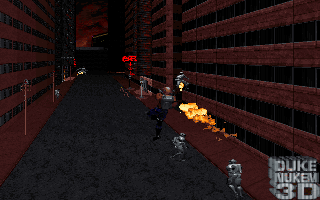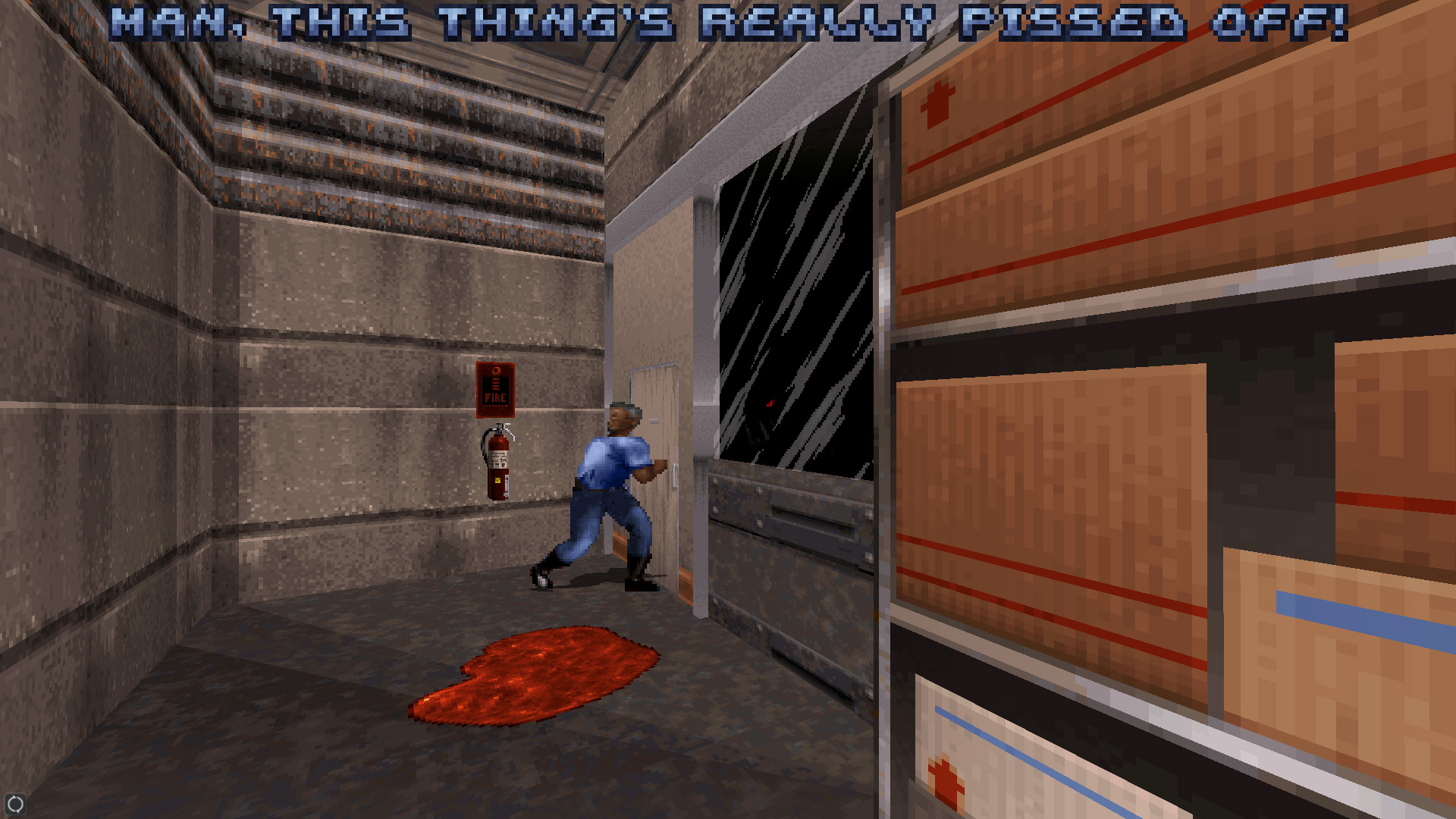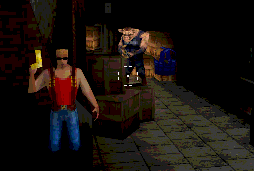
The 2020s, while still in their awkward, gangly youth, have somehow been a conveyer belt of banner years for Shit You Never Thought Would Happen. From the official release of the source code to 3D Movie Maker – a multimedia toy I lost entirely too much of my early online life to – through to the mammoth Nintendo Gigaleak and the myriad secrets it exposed about one of the games industry’s most secretive studios during one of its many golden ages, all the way through to goddamned SimRefinery, the Pandemic Age has ended up being a socially-distanced excursion through the warehouse at the end of Raiders of the Lost Ark, digging through the crates and seeing what catches one’s gaze through varying lenses of legitimacy.

And chief among those, the Vaporware Carryover Champ, the King Kong of Stuff You Should Never Even Consider The Possibility Of Happening Except Oops It Just Did, is the release of a build of Duke Nukem Forever from late 2001. Which is to say, the period when that trailer – yes, that one - was made, and people thought the game would be good, as opposed to, well, what it ended up as.
The sheer bloody acrimony surrounding DNF’s labored, frequently-rebooted development means there’s almost as many histories of its development as there were people who worked on it[1], a veritable Rashomon of he-said/he-said[2] that frequently conflicts with each other. It was 90% complete, but also it was mostly unpopulated test rooms! And so on and so forth. An actual, functional build that we can poke and prod and spelunk around the innards of provides a snapshot of the game in whatever state it was at that point in time, providing a datapoint far more objective and weighted in truth, for lack of a better word, than a bunch of middle-aged Texans joylessly grinding their way through an unceasing litany of half-forgotten eternal feuds like a shit version of the Hatfields and McCoys[3].
Now, let’s be clear. The leaked build is not, under any circumstances, 90% complete. It’s basically a disconnected pile of neat ideas and cool low-poly environment art that could have been glued together into an amazing Half-Life style game with some ideas a few years ahead of their time (the bike section, for example, is basically an unfinished nucleus for Half-Life 2’s vehicle sections some three years early[4] if only someone had started impatiently tapping their wristwatch and throwing around deadlines. I could wax lyrical about the weird blend of Half-Life and immersive-sim that sits here in a formative state that history sadly reveals it will never escape, but there will be many others who can paint a far better word-picture of what is, was and never will be.

Rather, I’d like to focus my attention on an unassuming little subfolder included in the package, almost obscured by all the other source materials and the unfinished version of the intended campaign, simply labelled “E3 Video”. Ever since the E3 2001 trailer emerged, people have speculated about whether or not it was “fake” and scripted to an inch of its life, or actual gameplay. A former developer once wrote a shot-by-shot list of what was “real” and what wasn’t[5], but this leak answers the question definitively – the “E3 Video” folder contains a separate pile of map files for all of the scripted scenes!
This allows the curious player to see exactly what they were made up of, what if anything existed outside of the shot, and whether they were actual gameplay, modified maps rigged up for ease of recording specific behavior, or just an outright cutscene built specifically for the trailer that the player walked through like a glorified cameraman. Remember that scene of the guy holding the door shut shouting “Man, this thing’s really pissed off!” before getting pancaked by the door exploding out under the force of a monster obscured by turn-of-the-milennium compression artifacts on the other side? Now you can load that very scene, look around the few rooms sitting out of shot, find an appropriate position and angle, follow the on-screen instructions to trigger the sequence, and see exactly what the monster is[6] at your leisure as it loops its victory bellow animation infinitely after its grim task is done!

Now, I can see someone looking at these maps, dissecting how the game they fantasized over for like a decade and a half was a lie, and getting upset, and I can sympathize. But honestly? I find this stuff incredibly engrossing to dig through. I’ve developed a weird fascination over the years, forged further by websites like The Cutting Room Floor, with how the sausage was made on classic games, and this extends to their promotional material and how it often attempts to reflect a finished product that doesn’t quite exist yet by sandpapering over the unfinished bits with the hopeful expectation that said bits will be finished enough later that nobody who gets their hands on a playable demo or the final product will notice or care.
Admittedly, I’m not exactly an impartial observer on all this. If you haven’t browsed around the rest of this website, I make mods for Doom, and as such have made trailers to highlight the contents of said mods and their respective updates. I won’t claim to be a Derek Lieu-level master of conducting symphonies of carefully-composed gameplay footage, but I’ve learned how to put things together and rig things up to get what I want from a storytelling/editing perspective[7], so maybe I’m just interested in how the professionals commit the same sins that I’ve performed on the amateur circuit?
E3 stage demos are all, universally, to a letter, an Utter Fucking Shitshow behind the scenes. All hurriedly put together in a few weeks of the most brutal of crunchtimes to sell an idea, a vision of what a finished product will be, to a theater-load of jaded journalists and bored investors, to say nothing of the many thousands more watching via live-streams or post-show video recordings. An interjection into development schedules that poses the impossible, paradoxical task of showcasing features that haven’t actually been built yet[8] through some combination of pre-scripted cutscenes pretending to not be cutscenes and well-rehearsed play-acting by the increasingly-nervous developer on-stage making sure to hit their marks just right.

Of course, sometimes this backfires and features showcased with the assumption that they’ll be ready in non-fictional form for the final release never quite make the final cut. One only has to look as far as Watch Dogs and its ever-contentious loss of cool next-gen weather effects for an example of that. Or Halo 2’s suspicious lack of Earth levels for a game based around an alien invasion of Earth. The magic tricks behind showing off something that doesn’t exist yet hinge heavily on that one magic word: “yet”. There has to be an absolute certainty that the feature will become flesh before the game escapes its developmental prison, otherwise the spell is broken and all you have is a bigger mess than usual[9].
Which is why it’s so goddamn fascinating to peer behind the curtain of a game that effectively never actually ended up getting finished and released, but still went down this illusionistic promotional path in a way that we can now tear apart and examine for ourselves. To see the patchwork trickery that never quite got replaced with the real deal, and gain a deeper, hands-on understanding of how creative projects – and this extremely-storied creative project in particular – can go horribly wrong.
In a way, the 2001 prototype makes things a little more bitter, in that there’s something genuinely cool and fascinating sitting here in pieces, waiting patiently to be pieced together and sent forth to change an unsuspecting world. But alas, instead we have the well-documented tragedy of an undersized, chronically-underpaid indie team striving desperately to make lightning strike twice against all laws of physics and probability. If its any credit to those who did their time on the DNF Team over the decades, it’s now part of the public record just how close they got... and just how good they were at sleight of hand.
15 people as of 2001, apparently! The final release a full decade later specifies hundreds of people, though a lot of this is mostly due to Gearbox’s (admirable) blanket policy of crediting the entire company and the addition of Take-Two publishing credits, voiceover casts, console porting teams etc. ↩︎
I know normally the saying is “he-said/she-said”, but it readily becomes clear playing the 2001 build that there weren’t any shes involved, and that the hes were very, very lonely. ↩︎
I wrote this bit a couple of hours before the two original founders of Apogee/3D Realms (both fairly unreliable narrators in themselves – remember Earth No More, among other things?) started very publicly sniping at each other over this prototype, immediately proving my point. ↩︎
At least one person listed in the 2001 build’s credits is also listed in the credits of Half-Life 2, apparently breaking a lengthy streak of working solely on games that never quite reached release. And what a game to break it with! ↩︎
See here: https://forums.duke4.net/topic/4164-dnf-2001-breakdown/. See, these footnotes aren’t just a bunch of lame jokes and asides! There’s actual info here! Granted, this leak suggests that this list isn’t necessarily 100% accurate, but granted it was someone trying to remember the intricacies of something they worked on ten years previous. Human memories are “fun” like that. ↩︎
It’s a musclebound feral pig guy, if you were curious. One of several concepts to survive into the final 2011 release in one form or another. Almost as many ideas from the 2001 release survived to the final game as were discarded to chase the flavor of the month! ↩︎
In my case, this mostly entails launching the game with -nomonsters enabled and manually spawning actors as needed so I can demonstrate features in a controlled environment (by pasting them against said environment). I’m pretty sure I’ve only modified maps once, for the first Reelism 2 trailer, and I think most of those changes were incorporated into the v1.0 version of that level so... ↩︎
Or they’re in the process of being built, but can’t be publicly shown because they’re a glitchy mess that constantly causes t-posing, epilepsy-triggering strobing and debug text prints full of epithets. And if that sounds like too specific a set of examples to be real... ↩︎
And also, possibly a violation of truth-in-advertising laws. But if No Man’s Sky was able to escape its tumultuous launch without too much trouble, do you really have much to worry about? Maybe. I’m not a lawyer, this does not constitute legal advice, we’ve never spoken, and I don’t know you. [10] ↩︎
Secret bonus footnote! The background image isn't from DNF2001 either, it's from the test level in a prototype build of Time to Kill for PS1. ↩︎
| Go Back, Foul Demon! | To the Top | Get in Touch |